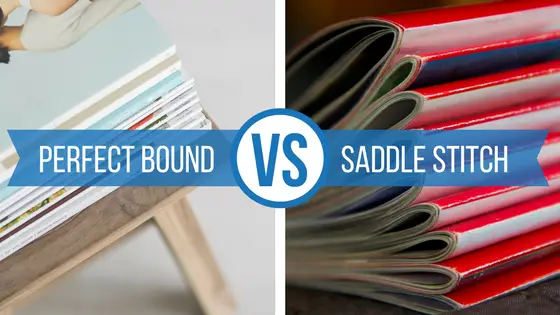Gal Shweiki and the Shweiki Media prepress department provide some insight into the details involved in determining the most appropriate type of binding for your publication. Learn the best uses and differences between perfect binding and saddle stitch; the cost savings associated with different bindery options; common printing industry jargon related to bindery; and how to calculate the spine width of your publication.
Free perfect-bound spine width calculator below.
When to Use Saddle-Stitch Binding
With saddle stitching, multiple pages are bound together along the fold with 2 or 3 staples. The fold on a saddle-stitch publication is also known as the “spine”. Saddle stitching is used to bind booklets that are 8 pages or larger. For saddle stitching to work, the booklet needs to be in page multiples of 4. (Note: An 11 X 17 sheet of paper that is folded in half to 8.5 X 11 is four pages.)
Saddle stitching is recommended for publications with less than 68 pages. It is also a more budget-friendly option and is a good option for magazines that are produced on a frequent basis. The limitation on the number of pages that should be contained in a saddle-stitch booklet is due to a phenomenon called page “creep,” and we’ll get into the specifics of that toward the end of this post.
When to Use Perfect-Bound Binding

Unlike magazines that use saddle-stitch binding, publications that use perfect binding are usually of a larger page count. Perfect binding involves the use of glue (rather than staples) to create the binding of a magazine. Shweiki recommends that any publication with more than 68 pages use perfect binding. Perfect-bound booklets have a flat spine. Adding copy on the spine of perfect-bound books is recommended to make your book stand out on a bookshelf and for quick identification. The saddle-stitch method cannot support larger quantities of pages. However, the cost difference between these two methods can be anywhere from $500 to $10,000 depending on the quantity of magazines, the caliber of the paper, and other external factors. Here is a table referencing the price differences for saddle stitching and perfect binding on a 64+4 page magazine with an 8pt cover and 60# gloss text (the most common paperweight combination):
Calculating the Spine Width of a Publication
The spine width of a magazine is the thickness of the publication. It is used when publishers wish to calculate how to size the text on the spine of a magazine. It is only necessary when publishers choose the perfect binding method of magazine binding.
Though there is a formula to calculate the spine width, Shweiki customers receive this calculation for their publications for free. The formula includes variables such as page count, page caliber (thickness of the paper, which ranges from .002 to .005), and even the glue, which adds to the spine width as well. Use the calculator below to determine the spine width of your publication.
Click to Launch The Calculator
Directions:
- Choose “Gloss Text”, “Matte Text”, or “Uncoated Offset”
- Enter the number of inside pages excluding covers
(i.e. If your magazine is a 32 + 4 page cover, only enter 32 pages) - Select the paper weight to see the result
- Hit “Clear” to start over
And you have the spine width for your publication!
What Is Page Creep?
Page creep is a characteristic of booklet binding in which the inner sheets stick out farther than those closer to the outside due to the paper thickness. When the edges of the booklet are trimmed flush after stitching, the width of the innermost sheet will be the narrowest in the book, with each successive sheet being wider than the next one (working from the inside of the book to the outside). The printed area of each page will appear to get farther from the outside margin as you go from the inside of the book to the outside.
Shweiki explains that to compensate for page creep, the pages are “shingled,” which means that the inner margin, or “gutter,” is increased on the pages working from the inside of the book to the outside. The gutter is successively wider page-by-page. The outside page has the widest gutter, and the inside page has the narrowest gutter. Increasing the gutter moves the printed area closer to the outside margin. When the pages of the book are trimmed flush, the printed copy appears to cover the same portion of each page. This procedure is not normally performed on booklets with only a few pages because the effects of creep are minimal on such publications; however, it should always be used on larger saddle-stitched books. (This is something your printer should take care of in the pre-press process before the publication is printed.)
Click here for information on how much it costs to print a magazine.


